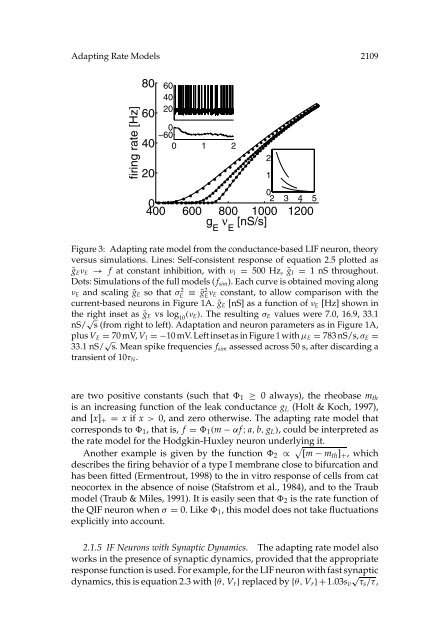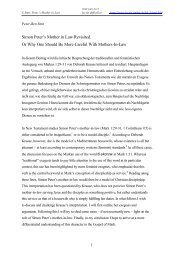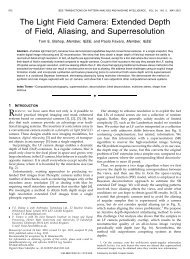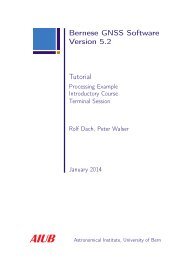Minimal Models of Adapted Neuronal Response to In Vivo–Like ...
Minimal Models of Adapted Neuronal Response to In Vivo–Like ...
Minimal Models of Adapted Neuronal Response to In Vivo–Like ...
You also want an ePaper? Increase the reach of your titles
YUMPU automatically turns print PDFs into web optimized ePapers that Google loves.
Adapting Rate <strong>Models</strong> 2109<br />
firing rate [Hz]<br />
80<br />
60<br />
40<br />
20<br />
60<br />
40<br />
20<br />
−60 0<br />
0 1 2<br />
0<br />
2 3 4 5<br />
0<br />
400 600 800 1000 1200<br />
g E<br />
ν E<br />
[nS/s]<br />
2<br />
1<br />
Figure 3: Adapting rate model from the conductance-based LIF neuron, theory<br />
versus simulations. Lines: Self-consistent response <strong>of</strong> equation 2.5 plotted as<br />
ḡ E ν E → f at constant inhibition, with ν I = 500 Hz, ḡ I = 1 nS throughout.<br />
Dots: Simulations <strong>of</strong> the full models ( f sim ). Each curve is obtained moving along<br />
ν E and scaling ḡ E so that σE<br />
2 ≡ ḡ2 E ν E constant, <strong>to</strong> allow comparison with the<br />
current-based neurons in Figure 1A. ḡ E [nS] as a function <strong>of</strong> ν E [Hz] shown in<br />
the right inset as ḡ E vs log 10<br />
(ν E ). The resulting σ E values were 7.0, 16.9, 33.1<br />
nS/ √ s (from right <strong>to</strong> left). Adaptation and neuron parameters as in Figure 1A,<br />
plus V E = 70 mV, V I =−10 mV. Left inset as in Figure 1 with µ E = 783 nS/s, σ E =<br />
33.1 nS/ √ s. Mean spike frequencies f sim assessed across 50 s, after discarding a<br />
transient <strong>of</strong> 10τ N .<br />
are two positive constants (such that 1 ≥ 0 always), the rheobase m th<br />
is an increasing function <strong>of</strong> the leak conductance g L (Holt & Koch, 1997),<br />
and [x] + = x if x > 0, and zero otherwise. The adapting rate model that<br />
corresponds <strong>to</strong> 1 , that is, f = 1 (m − αf ; a, b, g L ), could be interpreted as<br />
the rate model for the Hodgkin-Huxley neuron underlying it.<br />
Another example is given by the function 2 ∝ √ [m − m th ] + , which<br />
describes the firing behavior <strong>of</strong> a type I membrane close <strong>to</strong> bifurcation and<br />
has been fitted (Ermentrout, 1998) <strong>to</strong> the in vitro response <strong>of</strong> cells from cat<br />
neocortex in the absence <strong>of</strong> noise (Stafstrom et al., 1984), and <strong>to</strong> the Traub<br />
model (Traub & Miles, 1991). It is easily seen that 2 is the rate function <strong>of</strong><br />
the QIF neuron when σ = 0. Like 1 , this model does not take fluctuations<br />
explicitly in<strong>to</strong> account.<br />
2.1.5 IF Neurons with Synaptic Dynamics. The adapting rate model also<br />
works in the presence <strong>of</strong> synaptic dynamics, provided that the appropriate<br />
response function is used. For example, for the LIF neuron with fast synaptic<br />
dynamics, this is equation 2.3 with {θ,V r } replaced by {θ,V r }+1.03s v<br />
√<br />
τs /τ,
















